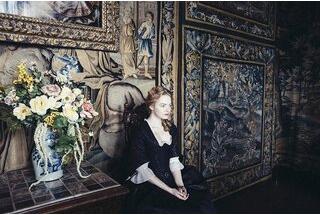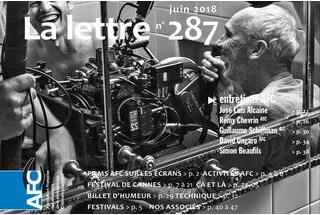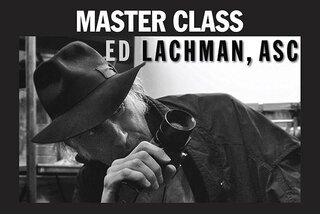Cinematographer Steven Poster adores Canon
By François Reumont for the AFC“While preparing this low-budget film,” he explains, “I did a lot of tests because I wanted to film with the least amount of light possible, especially in the interiors. In a certain way, my approach was quite similar to what I did on Donnie Darko, during the age of actual film stock.”
“At that time, Kodak had just released the 5289 (Vision 800T) with which I had entirely filmed that film and had a lot of success. Unfortunately, Kodak soon abandoned their pursuit of sensitivity, something I greatly regretted. I truly think that that was one of their greatest business errors. Really, a lot of people wanted more sensitive film in the early 2000s, rather than a very smooth image… which looked like images that were being produced by the new digital cameras!”
After a battery of tests on a number of cameras, Steven chose the Canon C500: “At 3,200 ISO, the C500 produces a better image than the Alexa or the Sony – whose sensor response is too linear for my taste. And I won’t even mention the Red!” he adds with a smile.
“I think it’s linked to the technology that tries to juice up the sensor in order to natively obtain high sensitivity. This is very different from the approach that consists in amplifying the signal later to add gain or to play around with it after digital development of the Raw. The Canon cameras of the Cinema EOS range are the only ones to make use of this principle (besides Panasonic with its latest Varicam).
The result is a very respectable image, whose level of digital noise seems to pass as a sort of film graininess. This sensation seems to me to come from the other discovery used by Canon and Arri on their camera, namely the random addition of pixels during filming, which emulates what used to happen on real film with the constant motion of the film reel and the change of the position of each photosite with each image.”
The result: interiors filmed at 3,200 ISO and daytime exteriors filmed at 1,250 ISO. “Filming at 3,200 ISO in daylight became a bit complicated with the filters. I chose 1,250 because it was the sensitivity that was the closest to the image structure in terms of result. By using the strongest internal neutral filter, and a polarizing filter in front of the lens, I posed at 80 ISO.
That corresponds exactly to what I would do with lighting when I still used film. In the interiors, the film was lit entirely with LEDs in bars and bands that were stuck to the walls… It was crazy, sometimes everything was powered entirely by battery. It was incredibly quick to set up!”
Discussing the exposure setting: “I have always used a spotmeter on my films. I believe that they are the most precise tool, and I complement them with a simple neutral grey at 18% that I have hung up on the set in order to measure each effect. Now, with digital, I don’t need a spotmeter anymore.
I just zoom with each camera onto the neutral grey and precisely adjust the aperture by basing myself on the readings of tools like the oscilloscope. Precision is just as important now as it used to be when we worked with film, because as soon as you have underexposure, the noise prevents you from splicing scenes together.”
Always quick to defend the role of the cinematographer, Steven Poster again insisted on the importance of having a camera operator: “It’s not just because I’m trying to proselytize as a member of a labour union, but really, in my opinion, it is complete nonsense to operate the camera and to deal with the lighting at the same time. Camerawork is something that demands so much concentration that you can’t correctly do both jobs at the same time. Working with a camera operator allows the cinematographer to prepare the next staging while the film continues to be shot… So I answer those who say that they need to see the image come together before their eyes in the camera by saying that nowadays, the viewfinders are objectively very bad compared with what one can see on a colour timed monitor.”
As far as the choice of lenses, Stephen Poster admitted that he loves the new Canon Cinema Lenses. “Both the three zooms and the fixed lenses are splendid. They are really defined, and yet don’t have a lot of contrast. That’s perfect for filming in digital, where you have to avoid contrasted lenses. Personally, on this film, I had three cameras, two of which were permanently filming, and a third set up for the Steadicam in order to enable us to quickly go from one staging to another.
In order to break down the high definition, I recommend everyone the new series of Tiffen Pearlescent filters, which to me are the ideal series of diffusers for digital. They soften the faces just the right amount, hardly create any “flare”, and what’s more, are very scratch-resistant. In fact, almost every shot in Amityville has at least a grade 2 filter.”
As far as recording goes, the cinematographer has a definite opinion on this question, too. “The C500 is a camera capable of doing 4K. But after our tests, Franck Khalfoun and I found this to be too defined. So I proposed a 2K recording format, but on external codex’s so that we could make use of the maximum colour depth of 12 bits. For me, that perfectly resumes one of the errors in which the camera industry has obstinately persisted for years. We don’t need definition, but colour quality! Moreover, nobody will tell you this, but filming in 4K is an open door to complete nonsense in terms of latitude in cropping during editing. It’s not the film editor’s job to frame the movie. That’s the director’s job via the intermediary of the camera operator. It’s as simple as that.”
Filming in 12 bits is great, but what about the “workflow” afterwards? “Indeed, the producer complained afterwards about the extra cost that the postproduction company billed him for to treat the special effects from 12 bit images (rather than the 10 bit images used in the traditional workflow). Alerted as to the situation, I still asked for tests to be done, in order to make things clear.
And I realized that resampling after filming in 10 bits really has no influence on the final image. In fact, from the moment that you’ve filmed the image with great depth of colour, the machines that go to work afterwards are capable of bringing that out on screen, even in a more limited colour timing.”
In terms of colour management, Steven Poster used simple colour-timing software on set. “Being able to benefit from a simple colour-timing tool live on set completely changes the team’s relationship to the image. It gives control back to the cinematographer, and you get that type of magic that we used to have when we worked with real film.
Of course, it doesn’t have the solemn aspect of the screening of the dailies that we used to have, but when you sit in front of the screen with your DIT, people fall silent, a little like in a magic show! Of course, this doesn’t allow you to have a finished image live on set, but you can make choices that will be saved in the metadata, and which will be able to later be used as a basis for the final colour-timing.”

In conclusion, the American Cinematographer also presented a few exclusive images from his last documentary that he worked on as director of photography, entitled Virtuosity, which focused on the 14th Van Cliburn international piano competition in Forth Worth. “I was very lucky to work on this project and to be able to film thirty candidates for the fourteen days of the competition in Texas, as well as in their home countries.
The result was really stunning. You have to see these young men and women, all piano virtuosos, confronting one another for fourteen days with sonatas and improvisations, and then confiding in the camera, sharing their fears, their hopes, and their lives.
Here, also, I chose to film with the Canon. But this time in C300, with internal HD recording. The captations filmed during the competitions were taken from nine cameras and a production truck. Larry Mc Conkey, Scorcese’s Steadicam operator, accompanied me on this fantastic movie, and I am very proud to have signed off on its image.”
This documentary by Christopher Wilkinson will be shown on American television in early January, and, we hope, will be distributed in Europe very soon afterwards…
(Translated from French by Alex Raiffe)
 En
En
 Fr
Fr







